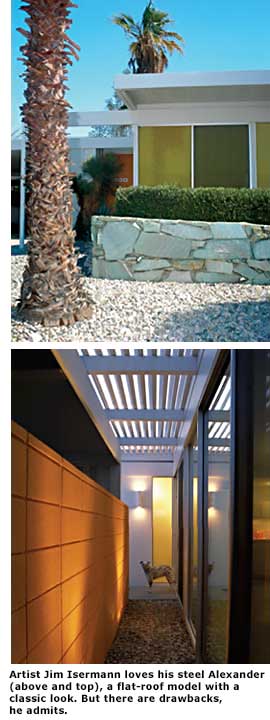Wexler's Palm Springs Steel - Page 2
But there was resistance to steel houses, in part because of their look. "Soriano was sensitive by force to the amount of steel a client would accept, and in the 1940s and 1950s that was not very much," Esther McCoy wrote in 'Blueprints for Modern Living: History and Legacy of the Case Study Houses.' "His ceilings were plastered, walls were usually a dark hardwood plywood, fireplaces were red brick, standard size or a Roman split."
The Alexanders weren't the first merchant builders to try steel. Eichler himself gave steel several shots. In 1955, working with Jones and Emmons, Eichler built a steel-framed showpiece house at Research Village, a model home project sponsored by U.S. Gypsum near Chicago. That same year, Eichler called upon Soriano to design the 'All-Steel Builders' house in Palo Alto. Jones designed Eichler's steel experimental house, the X-100, a year later in San Mateo Highlands. The house attracted much attention from the media and public. But Eichler never built another steel house.

It was the stresses of the desert climate, not Neutra's heritage, that got Wexler working in steel. Called to Palm Springs in 1952 to help design the tamarisk Country Club, Wexler was soon designing schools throughout the valley with partner Richard Harrison -- in steel.
Perlin, who was working for a Los Angeles steel company, Calcor Corps., knew about Wexler's steel schools and approached him in 1958 with another idea the company was developing -- steel houses. "I came by with as big a sample of a wall system as I could carry," Perlin remembers. The system used light-gauge structural steel and prefabricated panels and roofing.
U.S. Steel and Bethlehem Steel helped fund the project, hoping to develop new markets for their products.
Wexler was willing to try steel houses because of problems he'd had with an earlier house he built in Palm Springs -- a wood-framed house for himself. The wood warped in the heat, and required painting every few years. "That taught me," he says. "It was a good lesson, that wood is high maintenance."
They began by building a house for Perlin, on a hillside site in Los Angeles that today overlooks the Getty Museum. "For my house, I even went beyond overboard," he says. "The insides of the walls are steel. There's nothing that's not steel in our house other than the cabinets." Perlin still lives there. "It's relatively maintenance free," he says. "I painted it twice."
Wexler, who knew the Alexanders, convinced them to try steel for their next subdivision. "Originally we did three houses. Everything went along just beautifully," Wexler says. "Bob Alexander felt that as long as they were competitive with wood houses he wouldn't want to build anything else.
"Then a larger firm bought out Calcor. The long and short of the story, they upped the price on the steel. 'You've taken us out of competition,' Bob said."
"At the time," he adds, "a lot of developers were watching the Alexanders. I think Eichler was one of them."
Wexler and Perlin say steel houses were done in by the lack of industrial support. "Steel requires shop facilities and manufacturing that doesn't exist," Perlin says. Without that, he says, "It's like a custom anything. If you wanted a custom car, you'd have to pay a premium."
Designers of steel houses have also faced resistance from the trades. "Needless to say," Perlin notes, "the carpenters didn't want to have their livelihoods taken away."
Wexler also blames bureaucracy, the high cost of building permits, and cowardice for the failure of steel houses to take hold. "The whole thing is, who wants to be a pioneer?" he says. "The pioneer spirit has kind of left us. I don't see people experimenting as they did in the '50s, '60s or '70s."
Nonetheless, steel may be making a modest comeback in the desert. A new steel house was recently completed next door to Wexler's first Palm Springs house. Wexler served as design consultant. And the Los Angeles firm of Marmol + Radziner is marketing prefabricated steel-frame houses, shipping modules from its factory. Principal Leo Marmol is moving into 'the Desert House,' a flat-roofed, pristine prototype recently erected in Desert Hot Springs.
Wexler, meanwhile, remains proud of his steel neighborhood. "The seven steel houses, they'll never come down," he says. "Someone will have to bulldoze them or they'll be there forever."
• Donald Wexler and Bernard Perlin's seven Alexander steel houses can be found on Sunnyview Drive and Molino Road, half a mile from the Tramway Gas Station.
The Steel Mystique
When the architects who designed California's greatest steel-framed houses talk about the material, they focus on its functionality, strength, indestructibility, and its ability to span great distances. But don't let that fool you.




